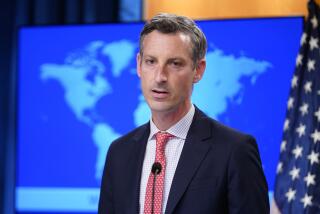THE MALTA SUMMIT : U.S.-SOVIET AGENDA FOR ARMS CONTROL
- Share via
\o7 VALLETTA, Malta\f7 — During their summit, President Bush and Soviet President Mikhail S. Gorbachev laid out this timetable to complete four sets of arms control negotiations:
Strategic Arms Reduction Talks, or START:
Current goal is to cut long-range offensive nuclear weapons by about 50%:
Final proposals from both sides to solve several remaining obstacles to be presented at or before two meetings of Secretary of State James A. Baker III and Foreign Minister Eduard A. Shevardnadze, in Moscow in January and in Washington in spring.
Issues will be settled and accord possibly signed at Bush-Gorbachev “arms control summit” in late June in Washington. But most officials believe technical and legal details will take several more months, delaying signing, perhaps, until 1991.
Conventional Forces in Europe (CFE) negotiations in Vienna:
Current goal is to cut NATO and Warsaw Pact military personnel and key conventional weapons to equal ceilings at least 10% below NATO levels and 50% below Warsaw Pact levels.
Accord to be completed for signature at end of 1990 at Vienna multinational summit. Participants would include all NATO and Warsaw Pact nations and possibly 12 European neutral nations.
Nuclear testing limits:
Verification procedures for monitoring provisions of two treaties, both signed more than decade ago but never ratified, would be finally agreed upon at June arms control summit. These so-called protocols would detail on-site and other inspection measures.
Chemical weapons cuts:
Details of U.S.-Soviet agreement to reduce arsenals of both sides to equal levels that would be 80% below current U.S. stocks and about 90% below much larger Soviet stocks would be completed. There is no firm timetable for this. But once all other chemical weapons-capable nations join the agreement, the two sides would cut stocks to 2% of current levels and stop production of new weapons.
More to Read
Sign up for Essential California
The most important California stories and recommendations in your inbox every morning.
You may occasionally receive promotional content from the Los Angeles Times.













